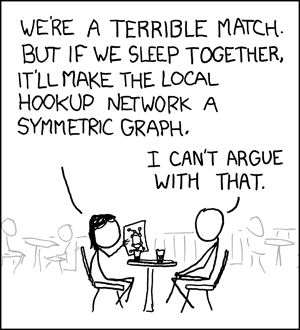Difference between revisions of "403: Convincing Pickup Line"
(Polish.) |
|||
| Line 9: | Line 9: | ||
==Explanation== | ==Explanation== | ||
| − | A {{w|graph (mathematics)|graph}} is a mathematical object consisting of '''nodes''' connected by lines called '''edges'''. The nodes could represent for example people, and the edges could represent a connection from having slept together. Now, Megan has such a graph. Arguably, a {{w|symmetric graph|graph that is symmetric}} is nicer than a regular one, why Megan suggests that they should sleep together. | + | A {{w|graph (mathematics)|graph}} is a mathematical object consisting of '''nodes''' connected by lines called '''edges'''. The nodes could represent for example people, and the edges could represent a connection from having slept together. Now, Megan has such a graph. Arguably, a {{w|symmetric graph|graph that is symmetric}} is nicer than a regular one, why Megan suggests that they should sleep together. |
| − | + | ===Title text=== | |
| + | This is a small-world joke on the concept of {{w|Erdős number}}. {{w|Paul Erdős}} was a Hungarian mathematician renowned for his eccentricity and productivity. He holds the world record for the number of published math papers, as well as for the number of collaborative papers. A persons Erdős number is the "collaborative distance" between the person and Erdős. Paul Erdős Erdős number is 0 by definition. All his 511 collaborators have the Erdős number 1. If you have written a paper with someone who's written a paper with someone who's ritten a paper with Paul Erdős your Erdős number is 3. If you know a mathematician or are a matematician you can calculate your Erdős number [http://www.ams.org/mathscinet/collaborationDistance.html here]. | ||
==Transcript== | ==Transcript== | ||
:[Cueball and Megan sit at a small table in a cafe. Megan holds up a graph.] | :[Cueball and Megan sit at a small table in a cafe. Megan holds up a graph.] | ||
| Line 18: | Line 19: | ||
{{comic discussion}} | {{comic discussion}} | ||
[[Category:Comics featuring Cueball]] | [[Category:Comics featuring Cueball]] | ||
| − | [[Category:Comics featuring Megan | + | [[Category:Comics featuring Megan]] |
| − | [[Category: | + | [[Category:Sex]] |
Revision as of 11:40, 1 December 2012
| Convincing Pickup Line |
 Title text: Check it out; I've had sex with someone who's had sex with someone who's written a paper with Paul Erdős! |
Explanation
A graph is a mathematical object consisting of nodes connected by lines called edges. The nodes could represent for example people, and the edges could represent a connection from having slept together. Now, Megan has such a graph. Arguably, a graph that is symmetric is nicer than a regular one, why Megan suggests that they should sleep together.
Title text
This is a small-world joke on the concept of Erdős number. Paul Erdős was a Hungarian mathematician renowned for his eccentricity and productivity. He holds the world record for the number of published math papers, as well as for the number of collaborative papers. A persons Erdős number is the "collaborative distance" between the person and Erdős. Paul Erdős Erdős number is 0 by definition. All his 511 collaborators have the Erdős number 1. If you have written a paper with someone who's written a paper with someone who's ritten a paper with Paul Erdős your Erdős number is 3. If you know a mathematician or are a matematician you can calculate your Erdős number here.
Transcript
- [Cueball and Megan sit at a small table in a cafe. Megan holds up a graph.]
- Megan: We're a terrible match. But if we sleep together, it'll make the local hookup network a symmetric graph.
- Cueball: I can't argue with that.
Discussion
I'm more intrigued by the Erdős–Bacon number, where Natalie Portman and Carl Sagan both have a six (5+1 and 4+2 respectively). Hogtree Octovish (talk) 06:47, 16 February 2013 (UTC)
- Wikipedia and erdosbaconsabbath.com say that Natalie Portman's EB is 7, not six. (Bacon 2, not 1.) Still awesome. gijobarts (talk) 03:36, 2 March 2016 (UTC)
- Stephen Hawking has a lower Bacon number than Erdos number. (2 and 4) Netherin5 (talk) 17:39, 13 March 2019 (UTC)
There's some irony here that they both think that they are terrible matches with each other, but both like the logic of making the graph symmetrical, indicating that they probably would be a good match Zachweix (talk) 16:57, 5 November 2018 (UTC)
One could argue that graphs that represent "(consensually) sleeping with each other" are always symmetric, making this a rather tautological pick-up line. 23:06, 21 March 2023 (UTC)
- Not every undirected graph is symmetric. 141.101.76.6 (talk) 11:11, 4 January 2024 (please sign your comments with ~~~~)
- Is it not? For every path (single- or multi-edge) from node A to node B, there will be an identical (reversed) one from B to A. It seems to me that this would introduce full symmetry regardless of configuration. 172.71.242.185 18:12, 4 January 2024 (UTC)
